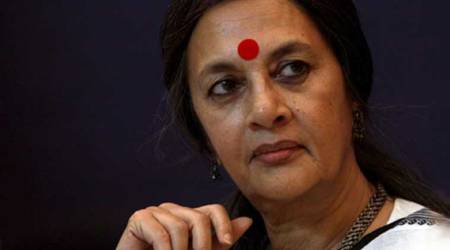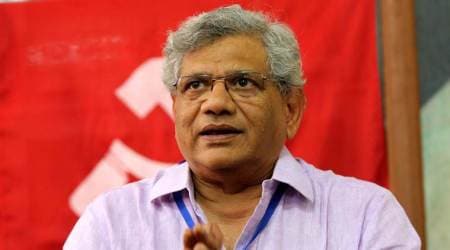 Mourners at the home of CPI(M)’s P V Raveendran, a day after his killing in Pinarayi on May 19, 2016, hours after the Left Front won the elections. (Source: PTI)
Mourners at the home of CPI(M)’s P V Raveendran, a day after his killing in Pinarayi on May 19, 2016, hours after the Left Front won the elections. (Source: PTI)
Kannur is an outlier in Kerala politics. Nearly a hundred men have been killed in this northern district in political clashes, mostly between the CPI(M) and the RSS, in the past two decades, according to an investigation by The Indian Express. The numbers are exceptional for Kerala, where politics is more of a battle of ideas than domination through violence. In Kannur, politics has revolved around the Communist movement since the 1930s. The CPI’s Kerala unit was formed in 1939 in Pinarayi, a village now famous as the home of Chief Minister Pinarayi Vijayan. Some of the top leaders of the Communist movement, such as A K Gopalan, are from Kannur.
The CPI(M), which has inherited the Left legacy, also dominates public life in the district through cooperatives and its numerous assets, including an amusement park. The RSS has sought to challenge this hegemony by aggressively expanding its shakha network and challenging the secular common sense that has evolved over decades of public action by a broad spectrum of political movements. Political mobilisation in Kannur had followed a different trajectory from the rest of Kerala even before Independence. Kannur was a part of British Malabar, which saw militant agrarian movements and peasant struggles in the pre-Independence decades. Politics in the princely kingdoms of Travancore and Kochi, the other two geographical regions that constitute Kerala, was shaped more by reform movements.
But after Independence, the Left politics in Travancore and Kochi focussed more on expanding its social base by engaging with communitarian outfits and relatively peaceful public action, whereas the legacy of peasant and labour militancy continued to shape politics in Malabar, especially Kannur. It could be argued that the first political murder in Kerala after Independence was of Moyyarathu Sankaran, a Gandhian peasant leader who joined the communist movement, in Kannur in 1948. Observers point out that all the major political groups in the region have used strong-arm tactics to protect or expand their turf at some point. This includes the Congress and the socialist groups that had pockets of influence in the region. But with their retreat, the RSS has stepped into the opposition space, as a rival to the CPI(M).
The CPI(M)-RSS violence in Kannur can be traced to the 1960s when workers of beedi factories struck work. With beedi workers forming the vanguard of the communist movement in the region, the factory owners called in the Jana Sangh-RSS, which had a base in neighbouring Mangalore. The battle to break the strike turned into Hindu-Muslim clashes, called the Thalassery riots of 1971. Thereafter, the CPI(M) and the RSS have intermittently clashed, except during the Emergency. Ironic as it may seem, the CPI(M)-RSS clashes, except in 1971, have rarely triggered a communal polarisation. In fact, a large majority of victims and the accused belong to the Thiyya community, a Hindu backward community. Clearly, this is a political battle. The CPI(M) perceives the RSS not just as a political rival but a threat to communal peace and working class solidarity.
Burdened by the legacy perhaps, politics is not any more imagined as a dialogic activity. People tend to identify with groups that have the resources, physical and material, to battle rivals. The leader, party and ideology become a seamless whole and demand unquestioned loyalty, besieged cadres guard their turf at all cost, and shifting of loyalty is interpreted as betrayal and punished. This also explains the existence in Kannur of party villages, where all families subscribe to a single political party.
The “partyisation” of politics has also reduced the influence of the civil society to broker peace when violence breaks out. Small skirmishes often result in murders. In recent years, the RSS has sought to capture religious places, especially of subaltern gods and goddesses, which have been under the patronage of CPI(M) cadres owing to communitarian reasons. Cadres have internalised the cycle of violence, so much so that any action immediately triggers a counter-attack, sometimes without the knowledge or approval of the leadership. The economic stagnation due to the decline of traditional industries and artisanal professions, and the lack of alternatives have also contributed to the political stasis. A large pool of dedicated cadres, drawn largely from the unorganised sector, undertake action on behalf of these parties. The landscape, dotted with martyrs’ columns and memorials, is a pointed reminder of the nature of the battle for political dominance.
Today, the CPI(M)-RSS rivalry in Kannur is almost a blood feud. The dependence of families caught in the spiral of violence on political patronage for survival has only sharpened and deepened rivalries. And, with the BJP in power at the Centre, the debate is turning into a battle of optics on the national stage. The BJP is targeting the image of a progressive and democratic party that the CPI(M) claims for itself nationally. Its narrative seeks to undermine the CPI(M)’s credentials as a party of governance. But then, the RSS-BJP’s battle with the CPI(M) is not merely an ideological struggle, it’s also a battle for Hindu votes. Containing the CPI(M) is essential for the BJP’s own growth in Kerala, where the bulk of middle and lower middle class Hindus across the caste divide vote for the CPI(M). Despite years of RSS work, the BJP is a marginal force in Kannur’s electoral politics.

